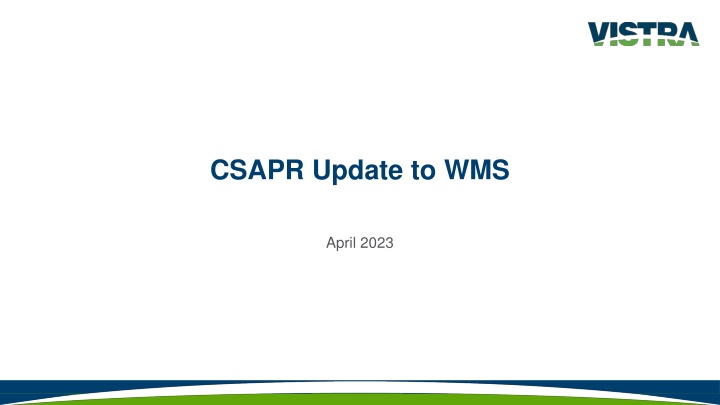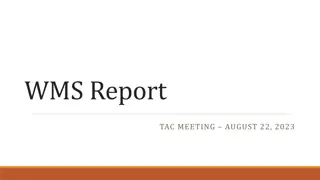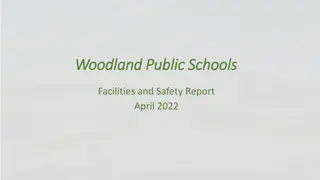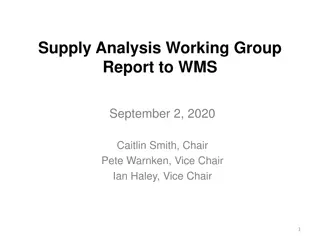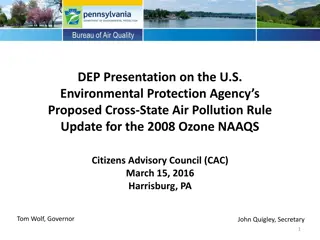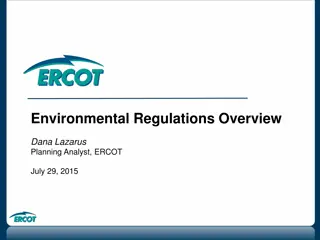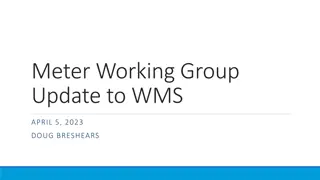CSAPR Update to WMS
Continuing the salvation story from Luke's Gospel, the Acts of the Apostles reveals pivotal events like Pentecost and Paul's conversion. Through the revelation process, God's work is displayed, shaping oral and written traditions within the faith community. Luke's sources, not typical historians, aimed to convey the significance of events for salvation, employing various literary forms. The Holy Spirit plays a crucial role, guiding the disciples in unfolding God's plan at critical junctures.
Download Presentation

Please find below an Image/Link to download the presentation.
The content on the website is provided AS IS for your information and personal use only. It may not be sold, licensed, or shared on other websites without obtaining consent from the author.If you encounter any issues during the download, it is possible that the publisher has removed the file from their server.
You are allowed to download the files provided on this website for personal or commercial use, subject to the condition that they are used lawfully. All files are the property of their respective owners.
The content on the website is provided AS IS for your information and personal use only. It may not be sold, licensed, or shared on other websites without obtaining consent from the author.
E N D
Presentation Transcript
CSAPR Update to WMS April 2023 1
CSAPR / Ozone Transport Status Update On March 15, 2023, EPA signed the final Federal Implementation Plan (FIP) that would establish an allowance- based ozone season trading program with nitrogen oxides (NOx) emissions budgets for fossil fuel-fired power plants in 22 states, including Texas as a Group 3 state, in addition to source-specific emission limits for certain industrial units The rule has not yet been published in the Federal Register The rule will be effective 60 days after publication The final trading program FIP moves units to CSAPR Group 3 and restricts allowance allocations along with additional enhancements The state budgets are calculated based on EPA s identified EGU control stringency of optimization of all existing post-combustion controls (SCRs and SNCRs) by the 2023 ozone season, the installation of state-of-the-art NOx combustion controls by the 2024 ozone season, and the addition of new post-combustion controls by 2026 and 2027 Overall, EPA relaxed the short-term requirements versus the rule proposal. The precursor for EPA s trading program FIP was the disapproval of numerous state implementation plans (including Texas, Illinois, and Ohio) that EPA finalized on February 13, 2023 On March 3, 2023, Texas AG, TCEQ, PUC, AECT, TCC, TX Oil and Gas, Business Coalition for Clean Air and others filed a motion to stay the disapproval 2
Key Changes to CSAPR Compliance Potentially higher variability limit than proposed EPA will determine each state s variability limit for a given control period so that the percentage value used will be the higher of 21 percent or the percentage (if any) by which the total reported heat input of the state s affected EGUs in the control period exceeds the total historical heat input of the state s affected EGUs Will be implemented starting with the 2023 control period instead of the 2025 control period Backstop daily limit Applies in 2024 only to coal-fueled units with existing SCRs Applies to units with new SCRs in second control period after installation, no later than 2030 3-for-1 allowance surrender applies after 50-ton threshold Assurance level backstop beginning in 2024 If state exceeds assurance level of 121% of budget, secondary backstop limit applies to any unit with post-combustion controls responsible for contributing to an exceedance of the state s assurance level 3-for-1 allowance surrender applies after 50-ton threshold Unit must have operated at least 10% of the hours of the control period Secondary emission limit is higher of of 0.10 lb/mmBtu or 125% of the unit s lowest previous seasonal average emissions rate would Potential administrative or judicial action and subject to penalties and other forms of relief under the CAA s enforcement authorities 3
Key Changes to CSAPR Budgets Budgets are higher than proposed Beginning in 2026, significant reductions expected Proposed generation shifting is no longer included in the budget determination but will be reflected in dynamic budgets New preset budgets are provided through 2029 based on Inventory adjustments for announced retirements, addition of new units Ozone Season 2021 heat rate as baseline with EPA-determined controlled emission rate New preset budgets establish the floor and may be replaced by the contemporaneously calculated dynamic budgets where the dynamic budget is higher For ozone seasons 2026 2029 only Dynamic budgets will be calculated and provided March 1 one year before and finalized by May 1 of prior year After 2030, new dynamic budgets establish allocations with no preset New bank recalibration target set at 21% until 2030 when it tightens to 10.5% 4
Response to Reliability Concerns EPA did not believe it necessary to add at reliability safety valve based on disagreement that the rule could cause resource adequacy or reliability issues In response to consultations with the RTOs, EPA made several changes to address the timing of new features of the rule Applicability of the daily backstop NOx emission rate for units that do not have SCR controls delayed until 2030 or upon installation of controls Units with SCR subject to backstop in 2024 3 to 1 retirement of allowances triggered after first 50 tons Recalibration of the bank to 10.5% is delayed until 2030, with a banking limitation of 21% set at beginning in 2024 Establishing a preset budget for years 2025 2029 that sets the floor for future budgets Dynamic Budgeting will be calculated annually and the larger of the preset or dynamic will apply 5
